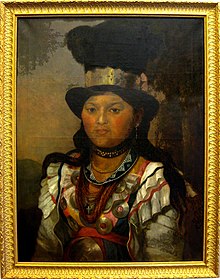Penobscot
[2] They are part of the Wabanaki Confederacy, along with the Abenaki, Passamaquoddy, Wolastoqiyik, and Miꞌkmaq nations, all of whom historically spoke Algonquian languages.For the rest of the year, the Penobscot and other Wabanaki likely had little difficulty surviving because the land and ocean waters offered much bounty, and the number of people was sustainable.It was lucrative and the Penobscot were willing to trade pelts for European goods such as metal axes, guns, and copper or iron cookware.Hunting for fur pelts reduced the game, however, and the European trade introduced alcohol to Penobscot communities for the first time.It has been argued that the people are genetically vulnerable to alcoholism, a racist sentiment with no evidence which Europeans frequently tried to exploit in dealings and trade.Penobscot people and other nations made pine beer, which had vitamin C; in addition to being an alcoholic beverage, it had the benefit of allaying the onset of scurvy.The population also declined due to further encroachment by settlers who cut off access to the Penobscot's main food source of running fish through the process of damming the Penobscot River, the loss of big game through the process of clear cutting of forests for the logging industry and through massacres carried out by settlers.[8] With a smaller population and greater acceptance of intermarriage, the French posed a lesser threat to the Penobscots' land and way of life.[5] After the French defeat in the Battle of Quebec in 1759, the Penobscot were left in a weakened position as they had lost their main European ally.During the American Revolution, the Penobscot sided with the Patriots and played an important role in the conflicts which occurred around the border between British Canada and the United States.The government believed that they were helping the Penobscot, as stated in 1824 by the highest court in Maine that "...imbecility on their parts, and the dictates of humanity on ours, have necessarily prescribed to them their subjection to our paternal control."[5] This sentiment of "imbecility" set up a power dynamic in which the government treated the Penobscot as wards of the state and decided how their affairs would be managed.The government treated as charitable payments those Penobscot funds derived from land treaties and trusts, which the state had control over and used as it saw fit.In addition, in an unprecedented step, five members of the Congressional Native American Caucus representing other jurisdictions filed an amici curiae brief in support of the Penobscot in this case.[12] The elementary school and the Boys and Girls Club on Indian Island are making an effort to reintroduce the language by teaching it to the children.[20] Klose-kur-beh provides humans and animals with practical skills needed to thrive in the unforgiving climate of the North East and punishes those who operated outside of his code.[20] This warning from such a prominent figurehead in Penobscot beliefs highlights that they upheld the values of preservation and protection of Maine's land and ecological resources.[21] The climax of the 1825 novel Brother Jonathan by Maine native John Neal is set on Indian Island during the American Revolutionary War.



Penobscot (disambiguation)United StatesAbenakiEnglishWabanaki mythologyChristianityWolastoqiyikMi'kmaqPassamaquoddyNortheastern Woodlandsfederally recognized tribeFirst Nationsband governmentAtlantic provincesQuebecWabanaki ConfederacyMiꞌkmaqAlgonquian languagesPenobscot Indian Island ReservationPenobscot RiverOld TownVerona Island, MaineEuropean colonizersMaine House of RepresentativesHugo ChavezNew EnglandJohn NeptunePeabody Museum of Archaeology and Ethnologyfur tradescurvymeaslessmallpoxFrench and Indian WarSeven Years' Wargovernor of MassachusettsSpencer PhipsBattle of QuebecAmerican RevolutionPatriotsMassachusettsreservationsTribal AgentNonintercourse ActUnited States Congressland claimsamici curiaeIndian law and sovereigntyPacific Northwest1974 Boldt decisionBetty McCollumTom ColeChickasawRaúl GrijalvaRon KindBen Ray LujánEastern AbenakiAlgonquian languageFrank SiebertBoys and Girls ClubRoman alphabetRoger WilliamsA Key into the Language of Americalanguage of the NarragansettLabradorIroquois languageNative American languageEthnobotanyAbies balsameamoccasinsAmerican Museum of Natural Historymade basketssweet grassbrown ashbirch barkhabitat destructionemerald ash borerMidwestwhite birchGluskbeBrother JonathanJohn NealAmerican Revolutionary WarMaulian BryantDonna M. LoringMadockawandosachemKing William's WarSherri MitchellWayne MitchellHorace NelsonOld John Neptunemedicine manHenry David ThoreauJoseph OronoLucy Nicolar PoolawDarren RancoUniversity of MaineJune SapielRebecca SockbesonUniversity of AlbertaTheresa SecordCharles Norman ShayAndrew SockalexisStockholm OlympicsLouis SockalexisCleveland GuardiansMolly Spotted ElkThe Silent EnemyssipsisWorld War IIArosaguntacookPennacookMaine Wabanaki-State Truth and Reconciliation CommissionMaine pennyPenobscot BuildingSt. Anne's Church and Mission SiteJoint Tribal Council of the Passamaquoddy Tribe v. MortonAmerican Friends Service CommitteeHarvard UniversityCatholic EncyclopediaWayback Machine